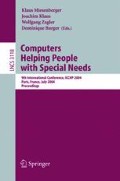Abstract
Traditional design of user interfaces is based on a perfect knowledge of the user’s interaction requirements for the target audience. This approach leads to user interfaces designed for a generic ideal user who doesn’t exist at all. As a result, every user or the interface has to adapt his/her own user’s interaction requirements to those of this ideal user. In a ideal scenario, there should be as many versions of the user interface as final users. Each of those versions would be designed to satisfy the user’s interaction requirements of a single user. Under this approach, we have designed GADEA, a user interface management system able to design different versions of a user interface, on the fly, depending on the cognitive, perceptive and motive skills of each user of the application. This system observes the users as they perform common tasks, analyzing their behavior in order to determine their interaction requirements.
Access this chapter
Tax calculation will be finalised at checkout
Purchases are for personal use only
Preview
Unable to display preview. Download preview PDF.
References
Apple Computer Inc.: Macintosh Human Interface Guidelines. Addison-Wesley Publishing Company (1992), ISBN 0-201-62216-562216
Card, S.K., Moran, T.P., Newell, A.: The Psychology of Human- Computer Interaction. Lawrence Erlbaum Associates, Mahwah (1983)
Jul, S., Furnas, G.W.: Navigation in Electronic Worlds: a CHI 1997 Workshop, October 1997. SIGCHI Bulletin, vol. 29(4). ACM Press, New York (1997)
Karn, S.K., Perry, T.J., Krolczyk, M.J.: Testing for Power Usability: a CHI 1997 Workshop, October 1997. ACM SIGCHI Bulletin, vol. 29(4) (1997), www.acm.org/sigchi/bulletin/1997.4/karn.htm
Lakoff, G., Johnson, M.: Metaphors We Live By. University of Chicago Press, Chicago (1980)
Lynch, J., Horton, S.: Yale Centre for Advanced Media (WWW Style Manual) (2000), http://info.med.yale.edu/caim/manual/ages/editorial_style.htm
Microsoft, Inc.: The Windows Interface Guidelines for Software Design (1998), http://www.microsoft.com/win32dev/uiguide/default.htm
Nielsen, J.: Alertbox (2004), http://www.useit.com/alertbox
Reynolds, C.: A Critical Examination of Separable User Interface Management Systems: Constructs for Individualisation. ACM SIGCHI 29(3) (1997)
Schwabe, D., Rossi, G.: Abstraction, Composition and Lay-Out Definition Mechanism in OOHDM. In: Proceedings of the ACM Workshop on Effective Abstractions in Multimedia, San Francisco, California (1995)
Shulz, E., Van Alphen, M., Rasnake, W.: Discovering User-generated Metaphors through Usability Testing. In: Proceedings of the Second International Conference on Cognitive Technology, Aizu, Japan (1997)
Sullivan, J.W., Tyler, W.S. (eds.): Intelligent User Interfaces. Frontier Series. ACM Press, New York
Wahlster, W.: User and Dialog Models for Multimodal Communication (1991)
Author information
Authors and Affiliations
Editor information
Editors and Affiliations
Rights and permissions
Copyright information
© 2004 Springer-Verlag Berlin Heidelberg
About this paper
Cite this paper
González Rodríguez, M., Pérez Pérez, J.R., Paule Ruíz, M.P. (2004). Designing User Interfaces Tailored to the Current User’s Requirements in Real Time. In: Miesenberger, K., Klaus, J., Zagler, W.L., Burger, D. (eds) Computers Helping People with Special Needs. ICCHP 2004. Lecture Notes in Computer Science, vol 3118. Springer, Berlin, Heidelberg. https://doi.org/10.1007/978-3-540-27817-7_10
Download citation
DOI: https://doi.org/10.1007/978-3-540-27817-7_10
Publisher Name: Springer, Berlin, Heidelberg
Print ISBN: 978-3-540-22334-4
Online ISBN: 978-3-540-27817-7
eBook Packages: Springer Book Archive

